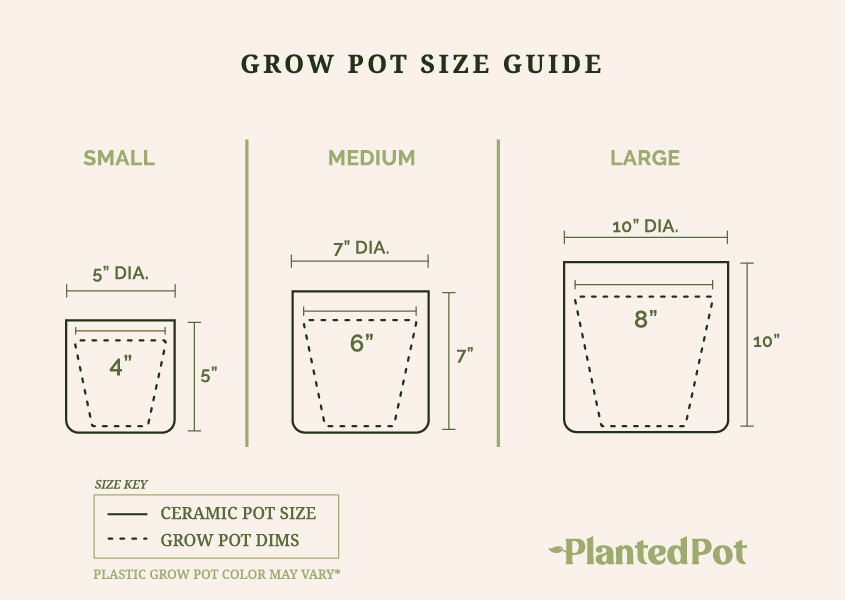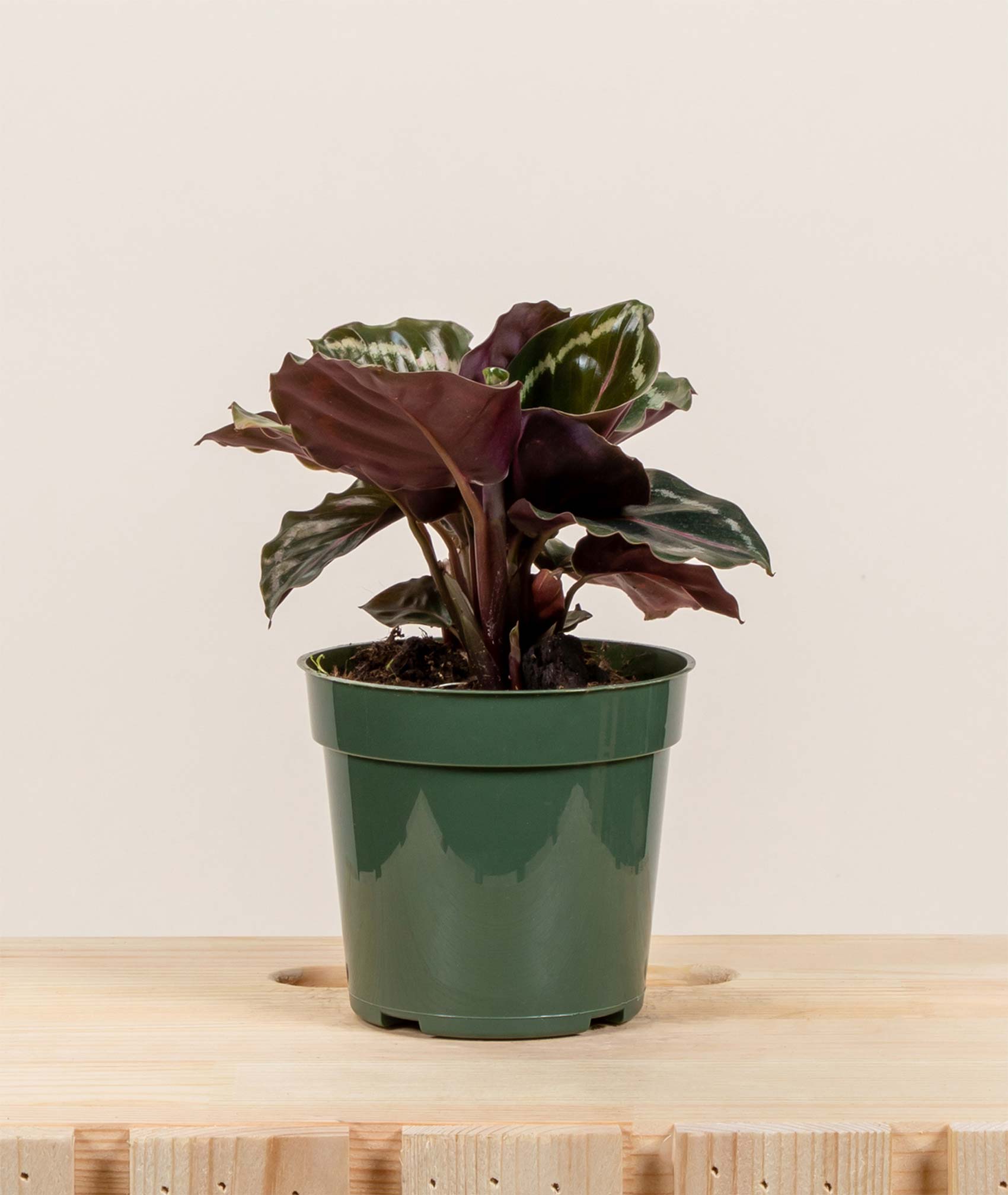
Calathea Medallion
$28
 Plastic grow pots come in different colors, you may receive a black or rust colored pot.
Plastic grow pots come in different colors, you may receive a black or rust colored pot.
The Calathea Medallion is a magnificent houseplant with sprawling leaves and a bold pattern that you will never get tired of looking at. The leaves are a striking green with light-colored patterns running along their center. When night comes around, the leaves tend to curl up, revealing a deep purple on the bottom of the leaves. The Calathea is bold and not afraid to be the star of the show. When placed in a room, this plant knows that everyone will be looking at it and always dresses for the occasion. The Calathea needs a careful watering routine to ensure the soil does not dry up, medium indirect sunlight, and fertilization one or two times a month. If you satisfy this beauty queen’s demands, you will be rewarded with a fabulous houseplant everyone will be talking about!
Medium to bright indirect light. Direct light will scorch leaves. More water in bright light, less water in dim light.
Keep soil moist, not overstaurated. Light, frequent watering. Water more in May-August, less in winter months
65°- 85° F
Related Products
Calathea Medallion
The Calathea Medallion, sometimes referred to as the rose-painted prayer plant, is a tropical species native to the South American country of Brazil. Both the Calathea and its close relative, the Maranta, are known to grow beautifully ornate foliage. To maximize light intake, Calatheas shift to open their leaves up towards the sun during the day and return to a resting position at night, following their circadian rhythm.
While Calathea plants come in various stunning colors and patterns, they can primarily be characterized by the dark red tint underneath the leaves and the pink or white “painted” pattern on top of the leaves.

What is a Calathea Medallion?
The Calathea Medallion (also known as Calathea roseopicta or Calathea veitchiana to its friends) is one of the most beautiful low-light plants that you can have in your home. Originating in the tropical Americas, they are relatively widespread among plant enthusiasts. This is because their large leaves sport a beautiful green pattern on top and a deep burgundy underneath.
- Size: Calathea Medallion is a moderately fast-growing house plant with an ultimate height of about 50cm.
- Light Requirements: While the Calathea needs plenty of diffused light, direct sunlight will cause the leaves to fade and lose their patterns. This plant can tolerate some shade, but the more light, the more rewarded you will be by delicate foliage. Experiment with different locations in your home to find the perfect spot for your Calathea.
- Temperature: The Calathea prefers warm to high temperatures, thriving in settings between 64° – 73°F. They can still cope with temperatures as low as 59°F. Ensure the plant has proper ventilation and do what you can to avoid draughts.
- How Often to Water: Plant parents must remember to walk the fine line between keeping Calatheas in damp soil at all times and never allowing the plant to sit in water or soak in very wet soil. If you own a Calathea Medallion, you may want to consider the phrase “little and often” as your watering policy.
Why Choose a Calathea Medallion Plant for Your Home?
The Calathea is a true eye-catcher in any space. It even contributes to a better and healthier indoor climate, as this houseplant purifies your air.
The Calathea is also unique because, unlike many other plants, they open their leaves in the day and close them at night! This is why they are called “prayer plants.”
We recommend that you keep a Calathea in the bedroom, as their humidifying capabilities, friendly leaves, and oxygenating properties can help you drift off at night and wake feeling refreshed!
Mental Health Benefits
Owning a houseplant comes with so many benefits. But did you know that houseplants are even good for your health? To put it simply, plants do the opposite of what we do when we breathe: they absorb carbon dioxide and release oxygen.
Not only does this freshen up the air, but it can also eliminate harmful chemicals and toxins that you may not even be aware of! NASA’s extensive research has revealed that houseplants can remove up to 87% of airborne toxins in as little as 24 hours.
Various studies like this one have also shown that indoor plants can improve productivity and concentration by up to 15 percent! On top of that, they can potentially reduce stress levels and heighten your mood — making them not only perfect for home but your workspace as well!
We suggest placing plants with broad leaves on your desk in the workplace. Fortunately, the Calathea Medallion is the perfect plant for this. Calatheas may help increase positivity levels while actively regulating humidity.
How can a plant make us feel more positive? When we look at greenery and nature, it triggers a biological response in which we feel more calm and relaxed, benefitting our day-to-day mood. Plants can serve both a practical and an aesthetic purpose in your space and may even enhance your everyday life.
Air Purifier
Clean air can be hard to come by in today’s world. Why not take the initiative and clean your own air? Rather than spending money on an expensive air purifier, why not let the beautiful plant life in your home take care of that for you!
Everyone knows that trees and plants produce oxygen, clean the air we breathe, and improve air quality. What is there not to love about that? Indoor plants can even absorb contaminants such as formaldehyde and benzene, both known to be carcinogens and lousy house guests.
Adds Beauty & Texture
Plants are beautiful, and many plant owners will attest that bringing a new plant into your environment can feel like a breath of fresh air. You can add any number of patterns and textures to your home with a well-placed Calanthea!
Are Calathea Medallions Good Indoors & Outdoors?
Their relatively easy maintenance makes Calathea plants popular as indoor plants. Though, plant parents and gardening enthusiasts alike can plant them in various locations and planters.
Calathea Medallions are moderately-sized plants that will typically grow to be about 1 or 2 feet tall. This makes them excellent indoor plants, provided you can provide the proper care for them.
Plant parents searching for a Calathea should also note that Calathea Medallions may potentially flower outside but will not do so indoors. While we recommend the Calathea Medallion be grown inside, they may still thrive in a shady spot outdoors.
Are Calathea Medallion Plants Pet and Children Friendly?
Calatheas are non-toxic to both pets and people. Though, you may still want to consider keeping these plants out of the little ones’ reach. A wide variety of animals find Calatheas relatively tasty, so we’d advise keeping them away from your pets to keep your plants intact!
Calathea Medallion Plant Family Relatives
Maranta leuconeura, also known as “prayer plants,” are members of the Marantaceae family. The Calathea is very closely related to Marantaceae plants. This can get complicated since some people also refer to Calathea Medallions as prayer plants.
Technically, the Calathea Medallion is not a “true” prayer plant. Marantaceae plants are the original prayer plants, though many people still consider the Calathea Medallion to be an unofficial member of the family!
Other members of the Marantaceae family:
- Zingiberales
- Arrowroot
- Maranta arundinacea
- Peacock Plant
Thanks to its beautiful, decorative leaves, the prayer plant is one of the most easily distinguishable tropical plants. The popular tricolor variety has deep green, arching red veins traveling to the leaf margins. Its velvety leaves sport yellow splotches down the midrib (the leaf’s middle).
Despite its relatively slow growth rate, the prayer plant can eventually reach up to a foot in height indoors. Prayer plants can be planted and cared for indoors during any time of the year and are relatively common as houseplants.
Because prayer plants and Calatheas are so closely associated with each other, it is quite common for them to be mislabeled and confused with one another. When it comes to the Maranta genus, a few species hold the spotlight as the most common:
- leuconeuraerythrophylla: This tri-colored plant, also known as the “herringbone plant,” is the prayer plant’s most popular variety and features beautiful red veins.
- leuconeura kerchoveana: Sometimes referred to as “Rabbit’s Tracks,” this variety sports plain green leaves contrasted by two rows of dark splotches.
- leuconeura massangeana: This elegant prayer plant has white leaf veins and a dark green color with silvery patches along the midrib.

Plants That Are Similar to the Calathea Medallion
Calathea leaves are long and broad. Depending on the type of Calathea, they may sport stripes and other markings in shades of green, purple, cream, or maroon. There are over two dozen varieties of this beautiful houseplant in the world.
Regardless of which variety you choose, they all generally require the same care and are all equally likely to liven up your space with a splash of greenery. Below, we’ve provided a list of the various types of Calathea plants that you may enjoy in your home:
- Lancifolia (Rattlesnake Plant)
- Ornata (Pinstripe Calathea)
- Roseopicta (Rose Painted Calathea)
- Makoyana (Peacock Plant / Cathedral Calathea)
- Zebrina (Zebra Calathea)
- Orbifolia (Round Leaf Calathea)
- Lubbersiana (Never Never Plant)
Final Thoughts – Calathea Medallion
Not only will a Calathea Medallion add a beautiful splash of greenery to whatever space they find themselves in, but they may potentially help to improve your quality of life! However, we do not recommend this particular plant for busy bees or beginners, as it requires a bit of extra love and care to keep it happy and healthy.





Reviews
There are no reviews yet.